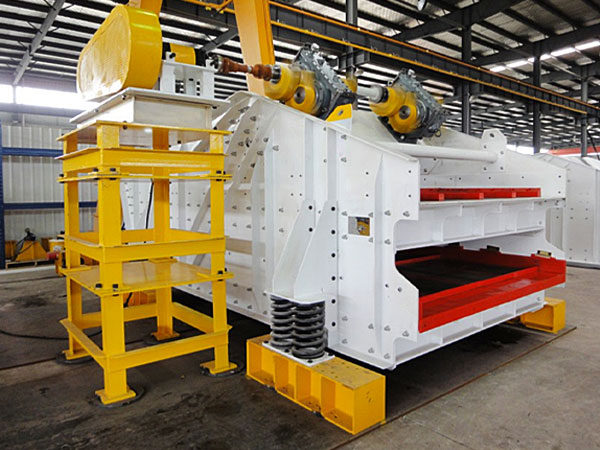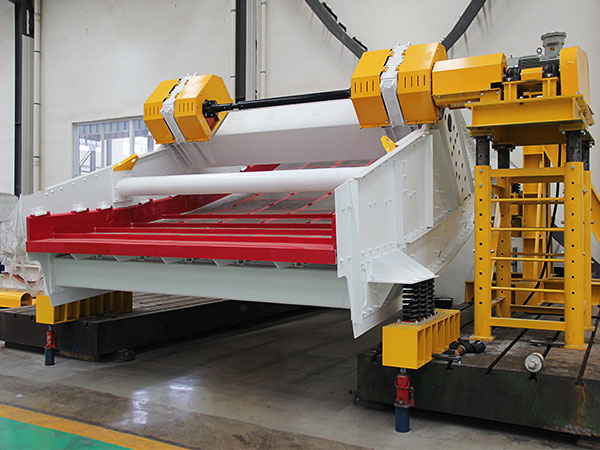How to prevent linear vibrating screen from clogging
Preventing a linear vibrating screen from clogging is a critical operational challenge. Clogging, also known as blinding (when fine, sticky particles block the apertures) or pegging (when near-size particles get stuck in the apertures), severely reduces efficiency, lowers product quality, and increases downtime for cleaning.
How To Prevent Linear Vibrating Screen From Clogging

The solution is rarely a single fix but a combination of adjustments across equipment, operation, and material properties. Here is a comprehensive guide on how to prevent clogging, broken down into key areas.
1. Select the Right Screen Media (The Foundation)
| Screen Type | Description | Best For Preventing |
| Self-Cleaning Screen Mesh | Made of individual wires that can vibrate independently, held together by polyurethane or rubber strips. The differential movement of the wires actively dislodges stuck particles. | Pegging and Blinding. This is one of the most effective solutions for difficult, near-size, or slightly damp materials. |
| Slotted (Rectangular) Mesh | Openings are longer than they are wide. This provides more open area and reduces the chance of near-size particles getting stuck. | Pegging. Ideal for materials with elongated or flaky particles. Note: Sizing accuracy can be slightly reduced. |
| Polyurethane or Rubber Screens | These materials are more flexible than steel. The openings are often tapered (wider at the bottom), which helps release particles. The natural flexibility helps “pop out” lodged material. | Pegging and high-impact applications. Excellent for abrasive or wet, sticky materials. |
| Woven Wire (Square Mesh) | The standard, all-purpose screen. While effective for many applications, it is the most prone to pegging with near-size, cubical particles. | General-purpose screening where clogging is not a major issue. |
2. Install Mechanical Anti-Clogging Systems
These are devices added to the screen deck to actively clear the mesh during operation.
Bouncing Balls / Slider Rings:
How it works: Rubber balls or polyurethane rings are placed in a compartment beneath the screen mesh. The screen’s vibration causes them to bounce or slide around, constantly striking the underside of the screen. This impact dislodges particles that are pegged or blinded.
Best for: Dry, granular materials from fine to medium sizes.
Ultrasonic Deblinding Systems:
How it works: A transducer applies high-frequency, low-amplitude vibration directly to the screen mesh. This “micro-vibration” breaks the surface tension and static bonds between particles and the screen wires, preventing fine powders from blinding the mesh.
Best for: Very fine, dry, or static-prone powders (e.g., metal powders, pharmaceuticals, pigments). This is a high-performance, but more expensive, solution.
Rotary Brush Systems:
How it works: A motorized nylon brush rotates underneath (or sometimes on top of) the screen, continuously sweeping the mesh clean.
Best for: Greasy, oily, or fibrous materials that tend to smear or agglomerate on the screen surface.
Water Spray Systems / Air Knives:
How it works: Nozzles spray a fine mist of water onto the screen surface to wash away sticky fines. This is only suitable for wet screening processes where adding water is acceptable. Air knives can be used for dry materials to blow away light, blinding particles.
Best for: Clay-like, sticky materials (water spray) or very light, dusty materials (air knives).

3. Optimize Operational Parameters
How you run the screen is just as important as the equipment itself.
Control the Feed Rate:
Overloading is a primary cause of clogging. A bed of material that is too deep dampens the screen’s vibration, preventing particles from stratifying and passing through the mesh.
Solution: Use a feeder (e.g., belt feeder, vibratory feeder) to provide a consistent, controlled, and even feed rate. Aim for a thin, fast-moving layer of material.
Ensure Even Feed Distribution:
Material should be fed evenly across the entire width of the screen. If it’s dumped in the center, that area will be overloaded and clog, while the sides will be underutilized.
Solution: Design the feed chute or use a distribution pan to spread the material out before it hits the screen.
Adjust Vibration and Angle:
Angle of Inclination: A steeper angle increases the material travel speed. This can reduce the chance of clogging but may also lower screening efficiency (less time for particles to pass through). Find the optimal balance for your material.
Vibration Amplitude (Stroke) & Frequency (Speed): A higher amplitude can help “throw” material more aggressively, dislodging stuck particles. However, too much force can damage delicate materials or the screen itself. Adjust the motor’s eccentric weights according to the manufacturer’s guidelines to find the right motion for your product.
4. Pre-Treat the Material
Sometimes, the best solution is to modify the material before it ever reaches the screen.
Drying: If clogging is caused by moisture making particles sticky, pre-drying the material using a fluid bed dryer or rotary dryer can eliminate the problem.
De-Dusting / Scalping: If very fine particles are blinding the screen, use a preliminary “scalping” screen with a larger mesh to remove coarse material first, or use an air classifier to remove the dust before screening.
Adding Flow Aids: In some industries (like food or pharma), adding a very small amount of an inert flow aid (e.g., fumed silica, magnesium stearate) can reduce inter-particle cohesion and prevent sticking.
5. Perform Rigorous Maintenance
A poorly maintained screen will not perform correctly and is more likely to clog.
Check Screen Tension: This is critical. A loose screen will flap instead of vibrating properly. It will have poor screening action and clog easily. A screen that is too tight can break prematurely. The screen should be “drum-tight.” Tap it to check for a consistent, high-pitched sound. Re-tension new screens after a few hours of operation.
Regular Cleaning: Implement a regular cleaning schedule. For difficult materials, this might be required at the end of every shift.
Inspect Motors and Springs: Ensure the vibratory motors are synchronized and running correctly. Check for broken or fatigued support springs. An uneven vibration pattern will create “dead spots” on the screen where material will accumulate and clog.

Quick Troubleshooting Guide
| Problem Symptom | Likely Cause | Primary Solutions to Try |
| Cube-shaped particles stuck in square holes | Pegging | 1. Switch to a Self-Cleaning or Slotted Mesh.
2. Install a Bouncing Ball deck. <br> 3. Increase vibration amplitude. |
| Fine, sticky powder coating the mesh | Blinding | 1. Install an Ultrasonic Deblinding System.
2. Pre-dry the material. <br> 3. Use a Self-Cleaning Mesh. |
| Clogging in the center of the screen only | Uneven Feed / Overloading | 1. Reduce the feed rate.
2. Install a feed distributor to spread material. |
| The entire screen bed seems sluggish | Poor Vibration / Loose Screen | 1. Check and tighten the screen tension.
2. Inspect motors and springs for damage. |
By following these five steps, you can systematically resolve linear vibrating screen blockage issues. You can effectively diagnose the root cause of blockage and implement a lasting solution for your linear vibrating screen. If you have any other questions, please feel free to contact us.



